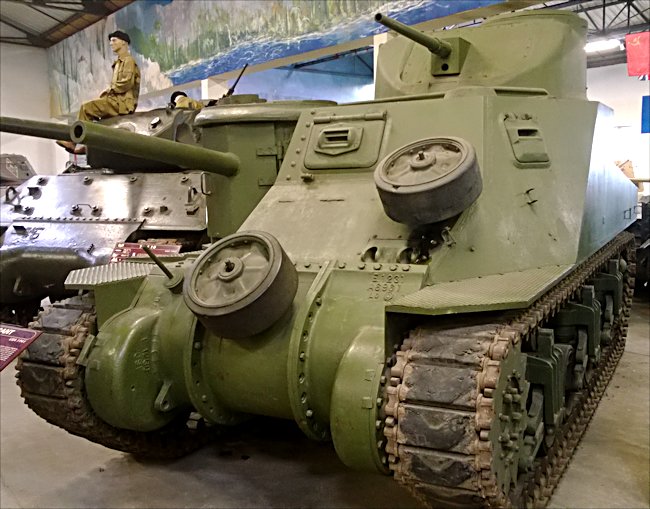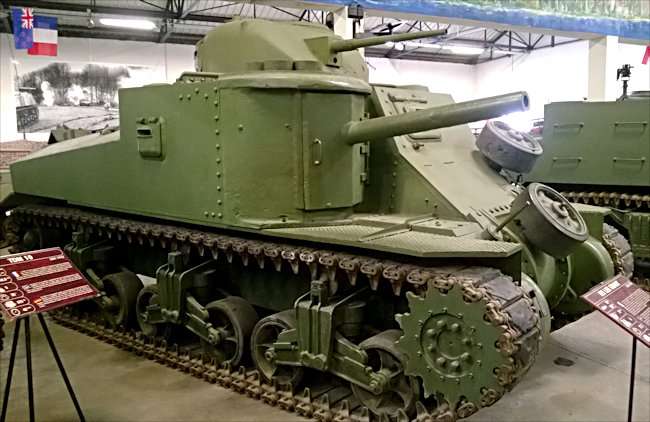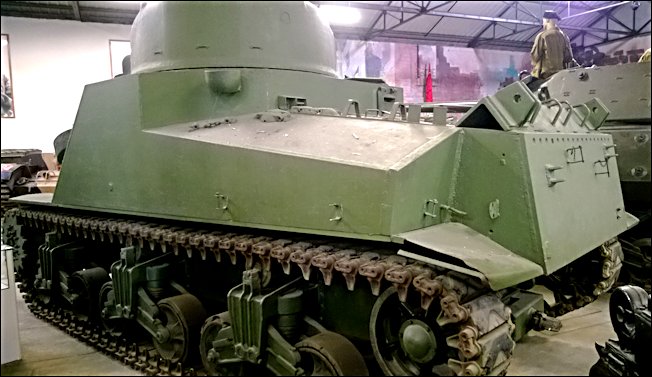M31B1 Grant Tank Recovery Vehicle
This M31B1 Tank Recovery Vehicle T2 can be found at the French Tank Museum in Saumur. It is a M3 Grant tank with both guns removed and replaced by dummy barrels, plus the addition of a rear mounted boom and winch, and tool boxes. (which have been removed)

M31B1 Grant Tank Recovery Vehicle French Tank Museum in Saumur
Produced as a 'limited procurement' conversion in September 1942, the T2 was redesignated M31 in September 1943 and classified 'limited standard'. M31B1 was the same conversion but based on a M3A3 tank chassis which had a welded hull and diesel engine. The M31B2 was based on the M3A5 which had a riveted Hull. (There is an example of a M3A5 in the Panzermuseum, Thun, Switzerland) The Winch had a 60,0001b pull. The gun mantle of the main gun has been turned into a door. The vision slit in the turret to the left of the gun is missing.
The M3 Grant Tank
The M3 series symbolised the rejuvenation of American tank research and development. The fact that the 75mm Gun was built into a limited traverse mount in the right sponson clearly was influenced by the pre-war design of the French Renault B tank and the original British WW1 tanks. The M3 rugged design and excellent speed for a medium tank was counterbalanced by a high profile and a very little sloping armour. It presented a very inviting target to the opposing German Panzer III and Panzer IV tanks.
The British called their M3 tanks the Grant after the American General. It had a different larger molded turret that housed a radio than the American M3 Lee tanks. The way to easily identify them is the British M3 Grant tank does not have a round Commander's Cupola on top of the turret. They just have a flat hatch.

Side view of a British M3 Grant Medium Tank
First 1942 battlefield reactions to the new M3 Grant tank
Trooper Jack Hodgkins of the 3rd Royal Tank Regiment was one of the first tank crews to operate the new American made M3 Grant tank in the Libyan desert in early 1942. He recalls, "It was a very good tank. We first got the Grant tanks just be for the battle of El Alamein and it was a turning point take it from me." The M3 Grants were a vast improvement over the fast but vulnerable Crusader tanks. They had 50mm of frontal armour providing greater protection for their six man crews. Its most unique feature was its powerful 75mm side mounted cannon.
Sgt Wilhelm Hagios was a member of an upgraded Panzer Mk III Ausf. J tank crew. He explained his initial reaction when coming across the new Grant tank. "This tank had a 75mm gun in a side sponson that was a disadvantage to us. The earlier versions of the Panzer III tanks with the 37mm gun had problems penetrating the M3 grants armour. The upgraded versions like the Ausf. J with the new 50mm KwK 39 L/60 long barreled main cannon had better luck.
The arrival of the Grant tanks was not enough to stop Rommel’s five month advance from Tobruk in Libya to the outskirts of the small coastal village of El Alamein in Egypt. Rommel was now only 300km from the Suez Canal. He thought victory was in his grasp, but the defensive minded British have a nasty surprise lined up for his troops.

Rear view of a British M31B1 Grant Tank Recovery Vehicle minus its rear winch.
By the 31st June 1942, over a 60km front, the British had massed a huge tank force near El Alamein. The Afrika Korps has taken a bashing after fighting their way across North Africa. They only have 2,000 Infantry, a few dozen artillery guns and just 55 serviceable panzers left. Any other commander with these low resources would dig in or retreat, but not Erwin Rommel he decided to continue with the offensive.
On 1st July 1942 the battle of El Alamein starts and goes on for 26 days. Rommel cannot break through the defences. The first battle ends in a stalemate. The RAF concentrates on attacking the German’s 2,000 km supply route. They estimate that 80% of their supplied do not get through to the front because of air attacks. The British have no problems with supplies. They even get a shipment of 350 new tanks along with a new commander Bernhard Montgomery.
The Grant tank changes 1942 desert warfare.
This is a news report that was filed Wednesday 10th June 1942 from General Ritchie's Headquarters by a British Reporter called Moorehead. - Enough has happened now to show that tank tactics in the desert have undergone a big change. Last winter the American Honey's and British cruisers tanks with their two pounder guns, charged in swerving. They mixed the fighting at close range and sometimes emerged out on the other side of the enemy's lines.
It was Hack and thrust at top speed, a fluid changing battle. Nearly all that has gone, except where tanks are in combined operations with infantry. It is open the little fighting now. The polka has become a Scottish reel.
Before writing this report. I waited 10 days while I visited British armoured units and compared their stories. Then returning to the rear areas. This morning I got all the confirmation I needed by spending a couple of hours in a tank workshop, going over damaged tanks, talking to the men who were in when they were hit.
This is often what happens now when we clash with the panzers. In the words of a British Tank Corps lieutenant, "We were waiting far south, near Bir Hakiem, libya, when the Germans came on us unexpectedly from behind. It took us 10 minutes to turn and form up in battle line. By that time the enemy had the best position."
"They split, as they always do, one wing wheeling on our right flank, one on our left. We sent two squadrons of tanks on our right and left to meet them. The General Grant tanks stayed in the centre ready to give support to either of our flanks. Our artillery guns went back. At this time, the Germans knew nothing of our new American M3 Grant tanks or the new six pounder anti-tank gun. They formed up expecting to out range us as usual."
"Suddenly at 1000 yards without budging from our position, we opened up. I did not know what sort of shock, they got when they first saw our 75mm shells crashing in. Quite clearly, they realised at once that they were up against something unexpectedly new and heavy, because they stopped"
"My first round even from the two pounder, knocked out a German mark III tank. Then it was an open dingdong go. Both sides. Sending shells across the 1000 yards and no one attempting to going closer. That then was the first stage of the new technique. Since then it has been developed steadily."
"There are days when British and German tanks occupy parallel and adjacent ridges not 5 miles. Both sides can see one another clearly. Then when they come for battle, they still keep well part. If possible the tanks take up a hull down position with just their turret showing over the ridges. Without moving from those positions they open fire."
"To this is added artillery, both anti-tank guns and field guns. Howitzers and often still heavier guns are brought up on the German side. It then becomes primarily and artillery battle, static in position, shattering in noise and often indecisive in result. The tank is nothing more than another gun or two with special armour, which can move quicker than an ordinary gun in an emergency."
"Such jewels lost at times the four, five or six hours. Sometimes Luftwaffe Stuka dive bombers and British bombers join in. Casualties in men are light, in machines heavy. Frequently one side or the other will retire to lead the enemy on to hidden guns in the rear, but everyone is becoming wary of that old ruse."
"There is no night tank fighting. Secret movements to new positions take place at night. This new kind of fighting has led many tank commanders to think that in the that end what is wanted here is not a tank at all, but a really big gun which is self-propelled and that has just a good big slab of armour in front of it."
"We have conquered our last winter disadvantage of only having two pounder guns. One thing you hear on all sides is the praise for the M3 Grant tank and are six pounder anti-tank guns. But of them the Germans might be at Mersa Matruh now."
I went for a look around the tank repair workshop. Damaged tanks were coming in straight from battle. Up to 40% are damaged so slightly that they have been repaired here inside three days. The tanks are given new crews to replace the wounded or killed men and sent straight back to the front.
"Look at that." said the Scottish Major in command of the workshop. His finger touched the spot where a 50 mm German shell had exploded on the side of the armour just above the tracks. It had pitted the steel with a series of tiny veins radiating from shallow central crater. There were 17 similar hits on the same tank. It had only come out of action because it's port track had partly broken under a correct it.
Whether or not these hits are slight because the German tanks are kept further at bay by our heavier guns, I do not know. The fact remains that with the dozen other tanks. I inspected it was the same story.
WW2 tank books

